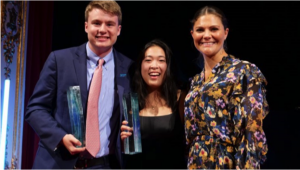
New York high school students Ryan Thorpe and Rachel Chang, receive the 2017 Stockholm Junior Water Prize from H.R.H. Crown Princess Victoria of Sweden in Stockholm
Photo credit: The Stockholm International Water Institute
At this summer’s Stockholm International Water Institute’s World Water Week meeting, two New York high school students were awarded the Stockholm Junior Water Prize for their rapid contaminant detection and water purification system. Ryan Thorpe and Rachel Chang accepted the prize from Crown Princess Victoria of Sweden at the August festivities.
The students engineered graphene-based biosensors to detect minute levels of specific bacteria in less than one second, a great improvement over conventional methods, which can take one to two days. An added bonus: The biosensors can detect as few as one colony forming unit (CFU) of bacteria. Other rapid DNA detection methods often require 1,000 CFUs.
The water purification part of the system is achieved by injecting hydrogen peroxide and sodium hydroxide into contaminated water. These chemicals react to produce hydroxyl free radicals, short-lived, highly reactive chemical species composed of oxygen and hydrogen. Hydroxyl free radicals eliminate organic matter (e.g., bacteria) in the water, producing carbon dioxide and water. Dr. Joan Rose, the 2016 recipient of the Stockholm Water Prize congratulated the “highly impressive and articulate young people,” noting, “The creative energy with which they have tackled a significant global challenge is exactly what the world community needs to get us to a better world for all.”